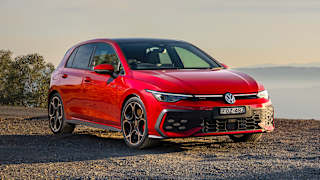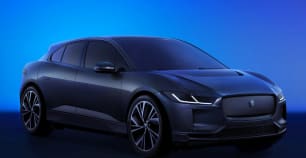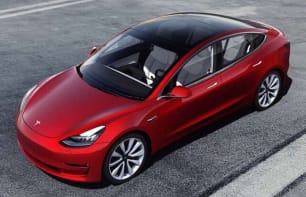Yes, compared to the vast mega screens invading most new models of today, the I-Pace’s dashboard layout is looking, well, off the pace. On first glance at least, this is definitely a product of the previous decade.
But as far as design elegance and functionality are concerned, Jaguar seems to have created a timeless piece of crafted automotive interior architecture that – consequently – holds up very well.
Or, in other words, the I-Pace provides a welcome sanctuary away from the infuriating folly of today’s faddish, fiddly and infuriatingly distracting touchscreen interiors. Maybe some old-school XJ smarts live on in this EV after all.
Look past the dated dashboard design, and the cabin’s overriding impression is of solidity and quality. No cheap plastics or rough surfaces here, just restrained luxury.
While electronic displays with very-analogue-style dial options amid digital driving data take care of the instrumentation ahead of the driver, a modestly-sized touchscreen is set at a lower plain so as to not dazzle and distract the job of vehicle controlling with data-overload, while under that is smaller display for climate control. More on that later.
Part of the Pivo Pro multimedia system, that central touchscreen is switched on and ready for use before the ignition button is even pressed, for immediate action.
No delaying-tactic welcome fanfare as the system boots up as per almost every other carmaker’s set-up, either. Just instant gratification, ironically. This dash is starting to feel like a resto-mod, with all the latest tech behind that Boris-era façade.
Plus, besides being fast, it is logically laid out and avoids confusing sub-menus. Nice swipey action, too. Some familiarisation is required at first, but the system makes sense. And if you need volume adjustability, you turn a physical knob. As the ergonomics lords intended. Easy.
Speaking of which, let’s get the sensible stuff out the way. Because it sits at near-SUV height, the I-Pace is easy to get in and out of as long as you’re aware of the swooping roofline out back. And you sit up high, affording excellent forward vision ahead.
Sinking yourself into the front seats, the Jaguar lives up to its old luxo-barge reputation in that they’re sumptuous yet firm in back-location and support, providing hours of comfort if required.
The driving position is superb, with ample adjustment and those thoughtfully-placed switchgear and controls coming into play.
Storage is ample, with deep door pockets, a sizeable centre console bin and even a secret cubby underneath the rear seat.
The Jaguar provides five USB outlets and two 12V sockets. And ventilation is as effective as you need it to be.
Problems? Pleasingly, our Graz-built Jaguar suffered from no breakages or squeaks. It is as well-screwed together as you’d expect from a luxury SUV, so there are no issues there to moan about.
However, rear vision is poor due to the tapering rear windows and shallow tailgate glass. In turn, the back-seat area can seem a bit dark and hemmed-in without the (optional) fixed glass roof.
The glove box is disappointingly shallow. And, though simple in execution, the climate control can be fiddly to figure out at first.
Of greater concern is the counter-intuitive transmission selection, since the ‘DNRP’ buttons are placed in descending order, putting ‘Drive’ up top and ‘Park’ down at the bottom.
On several occasions, ‘D’ was selected instead of ‘P’ or ‘R’, nearly leading to unintended forward acceleration into parked cars or walls directly ahead.
As mentioned earlier, our test HSE features the optional suede dash and pillar covers; along with the beautiful woven grey flannel-like trim on Alcantara-like seats, they add a distinctive classy ambience – and that’s something that translates out back, too.
While you wouldn’t call it a large wagon, it is more than sufficiently spacious for two adults, while middle-seat space is A-OK for smaller folk only as the ceiling tapers a bit too much for taller passengers. Legroom is exceptional, thanks in part to a stretchy near-3.0-metre wheelbase.
The bench seat itself does not slide or recline, but the 40/20/40-split backrest seems sufficiently angled for comfort and support, while the cushion is sprung enough not to lead to achy thighs, even for longer-legged occupants.
Amenities include rear-facing air vents, a centre armrest with two cupholders, two USB and a single 12V port, overhead grab-handles and reading lights, (quite shallow) door pockets, four coat hooks and some under-seat storage.
Further back, the Jaguar’s boot area is set up high, so requires some lifting to get heavier objects in, but the floor is long and flat, and the overall volume is quite practical. Capacity varies from 656 litres to 1453L with the backrests dropped. You can fit a 1797mm by 1244mm object in two-seater only mode.
There’s storage underneath for charging cables, as well as straps and hooks to secure loose items. And, as mentioned earlier, buyers can order a space-saver spare if the tyre-repair kit is undesirable. Note, too, that a sizeable ‘frunk’ front trunk is good for a couple of soft overnight bags.
Overall, then, equipped as our $180K HSE was, the I-Pace’s interior is likely to impress.







